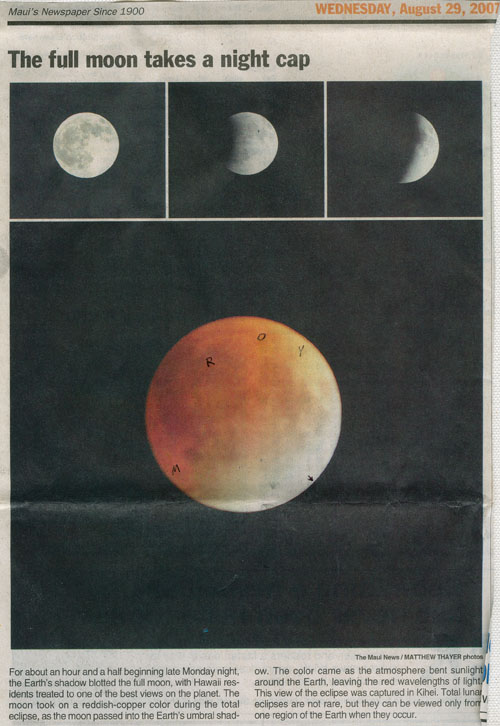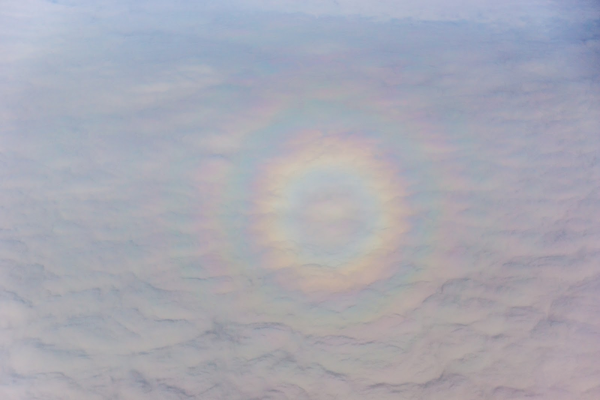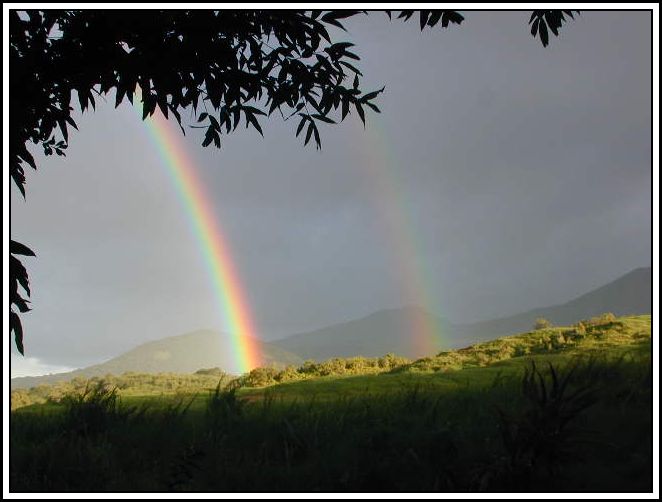|
determines what colors you see at that point. Your head is always in between the sun and the center of a rainbow circle, the sun is at your back. A normal rainbow has a lighter area of sky under it. White is the reflected color under the rainbow. Dark, or no added reflected light is over the top of the rainbow, over the red. Yellow light is in the middle of a rainbow. A warm magenta is barely visible on top of the red on a strong rainbow, it's stronger at the cool bottom of the rainbow. Also, yellow will appear again under the violet-magenta on a strong rainbow. If you make your own rainbow, with a small spray of water, you don't see the green, white will take it's place. This happens in the middle band. Red is on the outside of the main rainbow and on the inside of the second rainbow, the second rainbow is separated by 15 degrees actual an would have a darker band between them. The third rainbows color progression is the same as the main rainbow, ad infinitum. White light is reflected in the inside area of a complete circle rainbow, as seen from an airplane or above a valley or in a volcano creator filled with clouds, like Haleakala Creator. So it's lighter under a half circle rainbow. A rainbow has depth to it, all along the radius refraction angle of 45 degrees. A halo around the moon on vaporous clouds has red and magenta on the outside, the yellow is minor, green and cyan are the inside colors. The lighter area is to the inside. A moon bow is magenta, white, green, and rare. The opposite of white is clear, not black. Black in light terms is a hypothetical dark, best seen without light. :) Use the main rainbow's perpendicular drop line as the protracted zero angle, the second rainbow is at a 45 degrees closer angle to you, reversed. DISPERSION, diamonds, glass and water give dispersion of light with the proper incident and reflecting angles, thus splitting up white light into its spectrum colors. The water droplets in a rainbow are at the proper angle of refraction to give each color seen by you. Each person sees their own rainbow. The axis from the sun through your eye to the center of the rainbow's circle is the basis for the angle of an incidence you see as the rainbow's refracted light. Any medium in which the light travels more slowly than in a vaccum are called dispersive. For compleat interactive crystal color chart of color crystals and their compositions in a new window, go to my RCW Crystal Page. The ELBAITE crystal, H7.25, SG-3.05, trigonal, tourmaline group, transparent, pyroelectricity with heat, can show a compleat rainbow with these elements. IRON, green, red, and pink Magenta, brown.
FREQUENCIES are the number of waves that pass a point in space during any time interval, usually one second. It is measured in units of cycles (waves) per second, or Hertz (Hz). One hertz, one cycle per second. This frequency of visible light is referred to as color, the trailing visible range is from 460 trillion Hz, seen as red, to 750 trillion Hz, seen as the trailing end of violet. The full range of frequencies extends beyond the visible spectrum, from less than one billion Hz, as in radio waves, to greater than 3 billion billion Hz, as in gamma rays. The Hertz lowest number is red, when measuring in Nanometers or Angstroms the lowest number is violet. True magenta is not seen in the electromagnetic spectrum [EM].
WAVELENGTHS are unique to each color, they can be measured as one Nanometer which equals ten Angstroms. The electromagnetic spectrum is measured in Nanometers. DIFFRACTION is a light ray angling around a solid object. Diffraction enhances a painting rule, "It's darkest next to the light and lightest next to the dark". Diffraction also is the only way to see the atmospheric light color magenta in it's pure state. Diffraction is what happens to a ray at it's light stopping edge, stopped by an opaque object, it bends. The longest wavelength color can/will make the greatest diffracted angle. Magenta waves are still angling out of the straight white light that has already passed the stopping edge of the earth. They are moving in the shadow area on there way to a principal focusing point on the center line's axis, deep in the heart of the earths shadow.
Refraction - The longest red rays refract with the greatest angle out of a transparent prism, then the yellow, green, cyan, blue and magenta rays. This matches the CMYK color plates on my Real Color Wheel, Magenta extends farther into the cyan on one side of the color wheel making dark cyan change to Ult. blue. On the other side of the color wheel magenta extends farther into the yellow making the dark yellow a brown. the same way the magenta wave bends around the earth at sunset caused by diffraction.
 REFRACTION occurs when the energy of an incoming light wave matches the natural vibration frequency of the electrons in the transparent material. The light wave penetrates deeply into the material, and causes small vibrations in the electrons. The electrons pass these vibrations on to the atoms in the material, and they send out light waves of the same frequency as the incoming wave. But this all takes time. The part of the wave inside the material slows down, while the part of the wave outside the object maintains its original frequency. This has the effect of bending the portion of the wave inside the object toward what is called the normal line, an imaginary straight line that runs perpendicular to the surface of the object. The amount of bending, or angle of refraction, of the light wave depends on how much the material slows down the light. Diamonds would not be so glittery if they did not slow down incoming light much more than, say, water does. Diamonds have a higher index of refraction than water, which is to say that they slow down light to a greater degree. If one would conceder the earths atmosphere a soft crystal, like I do, surrounding the earth, we would see the refracted "green flash" light as it returned back through the atmosphere, as a Fresnel lens would have it. This effect is because the air crystal is thin in a curved lens shape, slice off the portion used by the suns light rays to see the Fresnel shape and stacking effect. I have seen this effect above the nuclear stacks on Lake Ontario in 2005.  The flash can be from one to two seconds and contain green, cyan, blue to purple light. Longer at higher latitudes. http://www.rwagner.de/projects/greenflash/ http://www.atoptics.co.uk/ One interesting note about refraction is that light of different frequencies, or energies, will bend at slightly different angles. Let's compare violet/magenta light and red light when they enter a glass prism. Because violet light has more energy, it takes longer to interact with the glass. As such, it is slowed down to a greater extent than a wave of red light, and will be bent to a greater degree. This accounts for the order of the colors that we see in a rainbow. It is also what gives a diamond the rainbow fringes that make it so pleasing to the eye. Magenta is the color in the center of an interferometer's white test for principal focus of diffracting dispersed light and making
INTERFERENCE colored light bands.
White light from the sun comes in transparent vibrating waves or rays, they're parallel, pulsed and diffracting, not bending, but emitting from the wave peaks. Red peaks out a little farther and reaches greater angles through the air. A LASER'S beam is a continuous mono frequency, monochromatic, and parallel light. It's a light that will only go in a straight line, it does not diffract and lose color. A laser produces this beam, and turns it on and off, making "bits" of light, carrying coded information. This lightis internally reflecting, never leaving a straight glass fiber cable. Total INTERNAL REFLECTION will keep an obliquely angled ray from leaving the reflecting skin of a substance. Light under water aimed with a narrower than 45 degree angle of reflection, will not leave the surface of the water but stay internally reflecting. A beam of light at 46 degrees will break from the water's surface at 1 degree, 44 degrees will stay internal. The REFRACTION ANGLE doesn't change inside the transparent substance, but only as it passes through the skin of the substance. CENTER OF CURVATURE, is the focusing point of a sphere or concave mirror. Lens's are converging, diverging or flat. Converging lens's are thicker in the center, a sphere focuses in it's center, as a droplet of water or a crystal ball. YOUR RAINBOW'S POSITION The shadow of your head through your head points to the center of the rainbow. If you ever happen upon "The Specter of Haleakala" you'll see your shadow on a valley of clouds below with a rainbow around your head. Extend a line from your heads' shadow in the center of the rainbow back to the sun. The extended line passes through your eye. Each eye sees a different rainbow, use your right eye and call this the rainbow's "connecting center axis line". The rainbow's plane is perpendicular to this line. Have you ever seen a bright rainbow with a clear sky behind it and the rain long gone?
Move the droplet a few degrees above or below the spectrum angle on the rainbows plane and receive each individual wavelengths color. Find the radius path where the mirror can be moved toward you and away from you keeping the same 45 degree reflection angle to the sun. If the reflection angle along the line of sights radius line stays constant, it will constantly reflect the sun back to you, that's the path of the rainbow, the arc of constant reflection 90 degrees adjacent to the sun. The second rainbow is reversed because we're seeing the condensed spectrum of the other polarized half at it's weaker end. This other spectrum angle of the droplet is also "color-polarized" by dispersion and compression. IT'S LIKE WE'RE IN THE CENTER OF A GAS CRYSTAL. From your viewing position the distance is 7 1/2 degrees between rainbows, this darker area is the axis neutral zone between the polarized halves of the atmosphere "crystal". The main rainbow's reflection angle to you is 45 degrees on the sun's center axis line. The rainbow itself is 90 degrees off the sun's center axis line. If the sun is overhead and you spray a homemade rainbow-halo around yourself, the main halo is 45 degrees below the horizon line and second halo is 15 degrees distance from the main halo, 30 degrees below the horizon line. The same ratio works for the real rainbow above the horizon line. Use the main rainbow's perpendicular drop line as the protracted zero angle, the second rainbow is at a 45 degree closer angle to you, polarized and reversed. Your viewing angle compresses the distance to 7 1/2 degrees. This is an unpolarized zone. The second rainbow is reversed and less bright because we're seeing the rainbows polarized version at it's weakest end. A rainbow moves with you, as can be seen when your plane's shadow on the clouds has a rainbow around it, or you drive in your car. One particularly beautiful rainbow is called the "King's Rainbow" I've seen it here on Maui. Because we're on an island, the sun can be at eye level on the horizon line. The sun on the horizon line will put the rainbow directly overhead and it could be off to the side of you, 90 degrees from you to the sun. Looking to the rainbow touching the earth it appears to go straight up, no curve, straight up. The King's Rainbow. What is the closest you have ever driven into a rainbow? I think I saw the color orange as I drove into the rain. It happened really fast but I was ready.. |
 Question:
Answer:
|

